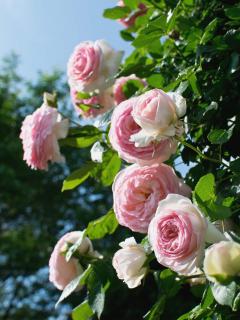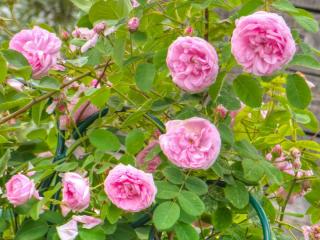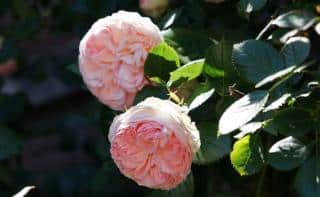

The Pierre de Ronsard ® rose tree blooms with large pinkish white flowers for nearly the entire summer.
Key Pierre de Ronsard Rose facts
Name – Eden Rose 85
Family – climbing rose tree
Type – repeat-blooming rose
Height – 6 to 10 feet (2 to 3 meters)
Breadth – 6 to 10 feet (2 to 3 meters)
Exposure: full sun, part sun – Soil: rich – Blooming: mid-spring → end of fall
Its bushy aspect and energetic vigor make it very resilient… this flower was truly graced with much good! The Ronsard rose tree was bred by Marie-Louise Meilland, the wife of famous rosarian Francis Meilland. This flower has gone through many adventures before reaching the envied status of becoming one of the most sold roses in the world.
You can set up your Pierre de Ronsard rose tree in the sun or in light shade for the hottest hours. But this rose tree needs at least 4 to 5 hours of sunlight a day to bloom well.
Plant this rose tree in a mix of garden earth and soil mix with, ideally, a layer of fertilizer lining the bottom of the hole.
As soon as it is in the ground, provide a lattice for it to climb along, and tie the branches often so that they don’t collapse.

If you purchase your Pierre de Ronsard rose tree with bare roots, it is a good idea to apply root dip before planting.
When purchased in nursery pots, the planting window is extended, and goes from spring to fall. Nonetheless, avoid days of dry spells and drought.
The fragrance is quite light, actually feels insignificant when compared to the impressive blooming.
Note that it is a repeat-blooming rose tree, and so will bear flowers several times a year.

If you prune your rose tree on a regular basis (once a year), you’ll be giving it what it needs to have a better growth, a nice stature and better blooming from spring to fall.
The Pierre de Ronsard climbing rose tree is a hybrid. It is a combination of 3 roses, the ‘Danse des Sylphes’, ‘Haendel’ and ‘Kalinka’.

It went on to have particularly noteworthy introduction: though the initial name of the flower was “Ingres”, the final name chosen for the rose was suggested by Christine Jossien, working for the City of Paris Parks and Greens department. Indeed, 1985, the year the rose was scheduled for release, was the 400th anniversary of the famous French poet Pierre de Ronsard.
In 2006, the rose tree earned the prestigious title of “Most beloved Rose in the World”, a title that awards recognition to the most beautiful roses in the world.
To this day, it is one of the most-sold rose trees on the planet.
The Pierre de Ronsard rose tree bears large double flowers that unfurl in a subtle gradient from white to pink. Its flowers mirror the characteristics of ancient heirloom roses.
Although the fragrance is rather discrete, the Pierre de Ronsard rose tree doubles down on an extremely dense and particularly long-lasting blooming since it extends from April to October-November.
Leafage is not also the poor parent, since its stark bright green marks a welcome contrast to its delicate flowers and colors.
Meilland, in breeding the Pierre de Ronsard rose, brought to life a particularly disease-resistant rose tree.
If however you notice spots on its leaves, intriguing yellowing or any other disease on your Pierre de Ronsard, refer to our rose tree diseases page.
Over the winter, neutral pH mulch like flax or hemp is recommended to keep it from freezing.